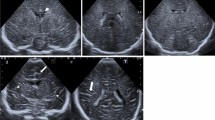Abstract
We present a neonate with molybdenum cofactor deficiency imaged at presentation during the first month of life and at 5 months with diffusion-weighted brain MRI. While the imaging features of this disease have previously been reported, this case highlights a distinctive initial pattern of widespread restricted diffusion involving cortex at the depths of sulci. Other case series have published diffusion-weighted images (DWI) with this pattern but never specifically commented on this finding. This distinct DWI pattern also accounts for the configuration of ulegyria frequently described on later imaging. Early recognition of this unique initial DWI pattern could avoid misdiagnosis and better direct counseling and management.


Similar content being viewed by others
References
Topcu M, Coskun T, Haliloglu G et al (2001) Molybdenum cofactor deficiency: report of three cases presenting as hypoxic-ischemic encephalopathy. J Child Neurol 16:264–270
Eichler F, Tan WH, Shih VE et al (2006) Proton magnetic resonance spectroscopy and diffusion-weighted imaging in isolated sulfite oxidase deficiency. J Child Neurol 21:801–805
Rodrigues K, Grant PE (2011) Diffusion-weighted imaging in neonates. Neuroimaging Clin N Am 21:127–151
Johnson JL, Wanders RJ (2001) Molybdenum cofactor deficiency and isolated sulfite oxidase deficiency. In: Scriver CR, Beaudet AL, Sly WS et al (eds) The metabolic & molecular bases of inherited disease, 8th edn. McGraw-Hill, New York, pp 3163–3177
Schwarz G, Mendel RR, Ribbe MW (2009) Molybdenum cofactors, enzymes and pathways. Nature 460:839–847
Reiss J, Bonin M, Schwegler H et al (2005) The pathogenesis of molybdenum cofactor deficiency, its delay by maternal clearance, and its expression pattern in microarray analysis. Mol Genet Metab 85:12–20
Veldman A, Santamaria-Araujo JA, Sollazzo S et al (2010) Successful treatment of molybdenum cofactor deficiency type A with cPMP. Pediatrics 125:e1249–e1254
Schwartz ES, Barkovich AJ (2011) Brain and spine injuries in infancy and childhood. In: Barkovich AJ, Raybaud C (eds) Pediatric neuroimaging, 5th edn. Lippencott, Williams and Williams, Philadelphia, pp 288–289
Conflicts of interest
None
Author information
Authors and Affiliations
Corresponding author
Rights and permissions
About this article
Cite this article
Stence, N.V., Coughlin, C.R., Fenton, L.Z. et al. Distinctive pattern of restricted diffusion in a neonate with molybdenum cofactor deficiency. Pediatr Radiol 43, 882–885 (2013). https://doi.org/10.1007/s00247-012-2579-8
Received:
Revised:
Accepted:
Published:
Issue Date:
DOI: https://doi.org/10.1007/s00247-012-2579-8




